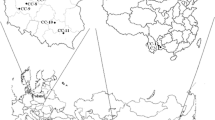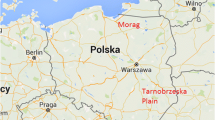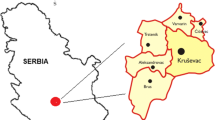Abstract
Fruiting bodies (500 g per site) of Tricholoma matsutake and the surface layer of soils collected from 20 spatially distant areas with pristine backgrounds across China were analyzed for potassium, magnesium, calcium, zinc, iron, copper, manganese and cadmium using inductively coupled plasma optical emission spectroscopy. In terms of the bioconcentration and bioexclusion concept, K, Mg, Zn, and Cu were highly bioconcentrated, and their bioconcentration factor values varied between 75-615, 2-107, 38-603 and 7-76, respectively, across the 20 sites. Fe, Mn and Cd were moderately bioconcentrated and their bioconcentration factors (BCFs) varied between 0.6-34.0, 0.4-37.0 and 0.9-7.0 respectively. However, Ca was excluded (BCF<1). T. matsutake is a species that is harvested in the wild as a valuable food and can contain a wide spectrum of both essential and hazardous mineral compounds that accumulate at elevated concentrations even if grown in pristine areas. The estimated intake rate of Cd in the fruiting bodies indicates cause for concern associated with this metal resulting from the daily consumption of between 200 and 400 g of fruiting bodies on a frequent basis during the mushrooming season.
Similar content being viewed by others
References
Brzostowski A, Bielawski L, Orlikowska A, et al. (2009) Instrumental analysis of metals profile in Poison Pax (Paxillus involutus) collected at two sites in Bory Tucholskie. Chemia Analityczna 54(6): 907–920.
Brzostowski A, Falandysz J, Jarzynska G, et al. (2011a) Bioconcentration potential of metallic elements by Poison Pax (Paxillus involutus) mushroom. Journal of Environmental Science and Health Part A 46(4): 378–393. DOI: 10.1080/10934529.2011.542387
Brzostowski A, Jarzynska G, Kojta AK, et al. (2011b) Variations in metal levels accumulated in Poison Pax (Paxillus involutus) mushroom collected at one site over four years. Journal of Environmental Science and Health Part A 46(6): 581–588. DOI: 10.1080/10934529.2011. 562827
Chang ST (1990) Composition of foods -mushrooms as food. Food Lab News 21(1): 7–8.
Cho IH, Choi HK, Kim YS (2006) Difference in the volatile composition of pine-mushrooms (Tricholoma matsutake Sing.) according to their grades. Journal of Agricultural and Food Chemistry 54(13): 4820–4825. DOI: 10.1021/jf0601416
Chudzynski K, Falandysz J (2008) Multivariate analysis of elements content of Larch Bolete (Suillus grevillei) mushroom. Chemosphere 73(8): 1230–1239. DOI: 10.1016/j.chemosphere. 2008.07.055
Ding X, Tang J, Cao M, et al. (2010) Structure elucidation and antioxidant activity of a novel polysaccharide isolated from Tricholoma matsutake. International Journal of Biological Macromolecules 47(2): 271–275. DOI: 10.1016/j.ijbiomac.2010. 04.010
Ding X, Hou YL (2012) Identification of genetic characterization and volatile compounds of Tricholoma matsutake from different geographical origins. Biochemical Systematics and Ecology 44: 233–239. DOI: 10.1016/j.bse.2012.06.003
EU (2008) Commission Regulation (EC) No 629/2008 of 2 July 2008 amending Regulation (EC) No 1881/2006 setting maximum levels for certain contaminants in foodstuffs. Official Journal of European Union L173: 6–9.
Falandysz J (2002) Mercury in mushrooms and soil of the Tarnobrzeska Plain, south-eastern Poland. Journal of Environmental Science and Health Part A 37(3): 343–352. DOI: 10.1081/ESE-120002833
Falandysz J, Brzostowski A (2007) Mercury and its bioconcentration factors in Poison Pax (Paxillus involutus) from various sites in Poland. Journal of Environmental Science and Health Part A 42(8): 1095–1100. DOI: 10.1080/1093452071418599
Falandysz J, Frankowska A, Jarzynska G, et al. (2011) Survey on composition and bioconcentration potential of 12 metallic elements in King Bolete (Boletus edulis) mushroom that emerged at 11 spatially distant sites. Journal of Environmental Science and Health, Part B 46(3): 231–246. DOI: 10.1080/03601234.2011.540528
Falandysz J, Drewnowska M, Jarzynska G, et al. (2012) Mineral constituents in Common Chanterelles and soils collected from a high mountain and lowland sites in Poland. Journal of Mountain Science 9(5): 697–705. DOI: 10.1007/s11629-012-2381-y
Falandysz J, Borovicka J (2013) Macro and trace mineral constituents and radionuclides in mushrooms: health benefits and risks. Applied Microbiology and Biotechnology 97(2): 477–501. DOI: 10.1007/s00253-012-4552-8
Falandysz J, Dryzalowska A, Saba M, et al. (2014) Mercury in the fairy-ring of Gymnopus erythropus (Pers.) and Marasmius dryophilus (Bull.) P. Karst. mushrooms from the Gongga Mountain, Eastern Tibetan Plateau. Ecotoxicology and Environmental Safety 104: 18–22. DOI: 10.1016/j.ecoenv.2014.02.012
Gill WM, Lapeyrie F, Gomi T, et al. (1999) Tricholoma matsutake -an assessment of in situ and in vitro infection by observing cleared and stained whole roots. Mycorrhiza 9(4): 227–231. DOI: 10.1007/s005720050271
Guerin-Laguette A, Shindo K, Matsushita N, et al. (2004) The mycorrhizal fungus Tricholoma matsutake stimulates Pinus densiflora seedling growth in vitro. Mycorrhiza 14(6): 397–400. DOI: 10.1007/s00572-004-0322-5
Gadd GM (2007) Geomycology: biogeochemical transformations of rocks, minerals, metals and radionuclides by fungi bioweathering and bioremediation. Mycological Research 111(1): 3–49. DOI: 10.1016/j. mycres.2006.12.001
Gucia M, Jarzynska G, Rafal E, et al. (2012) Multivariate analysis of mineral constituents of edible Parasol Mushroom (Macrolepiota procera) and soils beneath fruiting bodies collected from Northern Poland. Environmental Science and Pollution Research 19(2): 416–431. DOI: 10.1007/s11356-011-0574-5
Hoshi H, Yagi Y, Iijima H, et al. (2005) Isolation and characterization of a novel immunomodulatory a-glucanprotein complex from the mycelium of Tricholoma matsutake in basidiomycetes. Journal of Agricultural and Food Chemistry 53(23): 8948–8956. DOI: 10.1021/jf0510743
Hou YL, Sun SC, Wu LJ, et al. (2013) Calcium sensitizers isolated from the edible pine mushroom, Tricholoma matsutake (S. Ito & Imai) Sing. Zeitschrift Fur Naturforschung Section C 68(3-4): 113–117.
Iwase K (1997) Cultivation of mycorrhizal mushrooms. Food Reviews International 13(3): 431–442. DOI: 10.1016/S0167-7799(03)00204-X
Kalac P (2009) Chemical composition and nutritional value of European species of wild growing mushrooms: A review. Food Chemistry 113(1): 9–16. DOI: 10.1016/j.foodchem.2008.07.077
Kalac P (2012) A review of chemical composition and nutritional value of wild-growing and cultivated mushrooms. Journal of the Science of Food and Agriculture 93(2): 209–218. DOI: 10.1002/jsfa.5960
Kim JY, Byeon SE, Lee YG, et al. (2008) Immunostimulatory activities of polysaccharides from liquid culture of pinemushroom Tricholoma matsutake. Journal of Microbiology and Biotechnology 18(1): 95–103.
Kim M, Yoon H, Kim YE, et al. (2014) Comparative analysis of bacterial diversity and communities inhabiting the fairy ring of Tricholoma matsutake by barcoded pyrosequencing. Journal of Applied Microbiology 117(3): 699–710. DOI: 10.1111/jam.12572
Kuldo E, Jarzynska G, Gucia M et al. (2014) Mineral constituents of edible parasol mushroom Macrolepiota procera (Scop. ex Fr.) Sing and soils beneath its fruiting bodies collected from a rural forest area. Chemical Papers 68(4): 484–492. DOI: 10.2478/s11696-013-0477-7
Liu G, Wang H, Zhou BH, et al. (2010) Compositional analysis and nutritional studies of Tricholoma matsutake collected from Southwest China. Journal of Medicinal Plants Research 4(12): 1222–1227.
Liu HG, Zhang J, Li T, et al. (2012) Mineral element levels in wild edible mushrooms from Yunnan, China. Biological Trace Element Research 147(1-3): 341–345. DOI: 10.1007/s12011-012-9321-0
Li T, Zhang J, Shen T, et al. (2013) Mineral element content in prized matsutake mushroom (Tricholoma matsutake) collected in China. Chemical Papers 76(6): 672–676. DOI: 10.2478/s11696-013-0353-5
Melgar MJ, Alonso J, García MÁ (2009) Mercury in edible mushrooms and underlying soil: Bioconcentration factors and toxicological risk. Science of the Total Environment 407(20): 5328–5334. DOI: 10.1016/j.scitotenv.2009.07.001
Murata H, Yamada A, Maruyama T, et al. (2013) Root endophyte interaction between ectomycorrhizal basidiomycete Tricholoma matsutake and arbuscular mycorrhizal tree Cedrela odorata, allowing in vitro synthesis of rhizospheric “shiro”. Mycorrhiza 23(3): 235–242. DOI: 10.1007/s00572-012-0466-7
Ohnuma N, Amemiya K, Kakuda R, et al. (2000) Sterol constituents from two edible mushrooms, Lentinula edodes and Tricholoma matsutake. Chemical & Pharmaceutical Bulletin 48(5): 749–751.
Stijve T, Besson R (1976) Mercury, cadmium, lead and selenium content of mushroom species belonging to the genus Agaricus. Chemosphere 5(2): 151–158. DOI: 10.1016/0045-6535(76)90036-9
Vaario LM, Kiikkila O, Hamberg L (2013) The influences of litter cover and understorey vegetation on fruitbody formation of Tricholoma matsutake in southern Finland. Applied Soil Ecology 66(2): 56–60. DOI: 10.1016/j.apsoil. 2012.11.009
Wiejak A, Wang YZ, Zhang J, et al. (2014) Bioconcentration potential and contamination with mercury of pantropical mushroom Macrocybe gigantean. Journal of Environmental Science and Health Part B 49(11): 811–814. DOI: 10.1080/03601234.2014.938549.
Wang XM, Zhang J, Wu LH, et al. (2014) A mini-review of chemical composition and nutritional value of edible wildgrown mushroom from China. Food Chemistry 151(20): 279–285. DOI: 10.1016/j.foodchem.2013.11.062.
Wang XM, Zhang J, Li Tao, et al. (2015) Content and bioaccumulation of nine mineral elements in ten mushroom species of the Genus Boletus. Journal of Analytical Methods in Chemistry 2015, Article ID 165412. DOI: 10.1155/2015/165412
Yamada A, Maeda K, Kobayashi H, et al. (2006) Ectomycorrhizal symbiosis in vitro between Tricholoma matsutake and Pinus densiflora seedlings that resembles naturally occurring ‘shiro’. Mycorrhiza 16(2): 111–116. DOI: 10.1007/s00572-005-0021-x
Yang XF, Luedeling E, Chen GL, et al. (2012) Climate change effects fruiting of the prize matsutake mushroom in China. Fungal Diversity 56(1): 189–198. DOI: 10.1007/s13225-012-0163-z
Zhang D, Zhang Y, Morawska E, et al. (2013) Trace elements in Leccinum scabrum Mushrooms and topsoils from Klodzka Dale in Sudety Mountains, Poland. Journal of Mountain Science 10(4): 621–627. DOI: 10.1007/s11629-013-2384-3
Zhang J, Hull V, Huang J, et al. (2014) Natural recovery and restoration in giant panda habitat after the Wenchuan Earthquake. Forest Ecology & Management 319(3): 1–9. DOI: 10.1016/j.foreco.2014.01.029
Author information
Authors and Affiliations
Corresponding author
Additional information
http://orcid.org/0000-0002-9772-8617
http://orcid.org/0000-0002-0627-2061
http://orcid.org/0000-0002-5595-6937
http://orcid.org/0000-0001-5203-362X
http://orcid.org/0000-0002-1065-2024
http://orcid.org/0000-0001-9647-5307
http://orcid.org/0000-0002-2502-9577
Electronic supplementary material
Rights and permissions
About this article
Cite this article
Li, Q., Li, Sh., Huang, Wl. et al. Mineral constituents of a prized edible mushroom (Tricholoma matsutake) and soils beneath the fruiting bodies from the production areas across China. J. Mt. Sci. 13, 2046–2052 (2016). https://doi.org/10.1007/s11629-015-3568-9
Received:
Revised:
Accepted:
Published:
Issue Date:
DOI: https://doi.org/10.1007/s11629-015-3568-9




